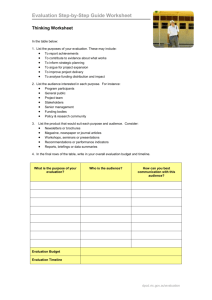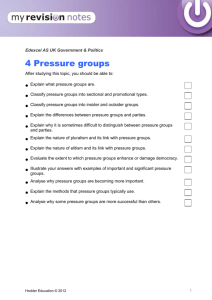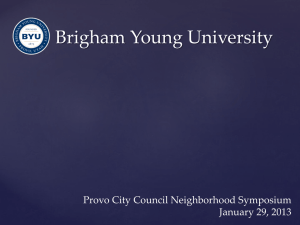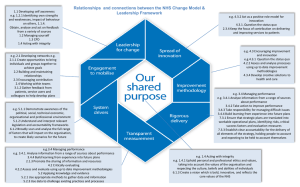Ruby Town Background Report Outline
advertisement
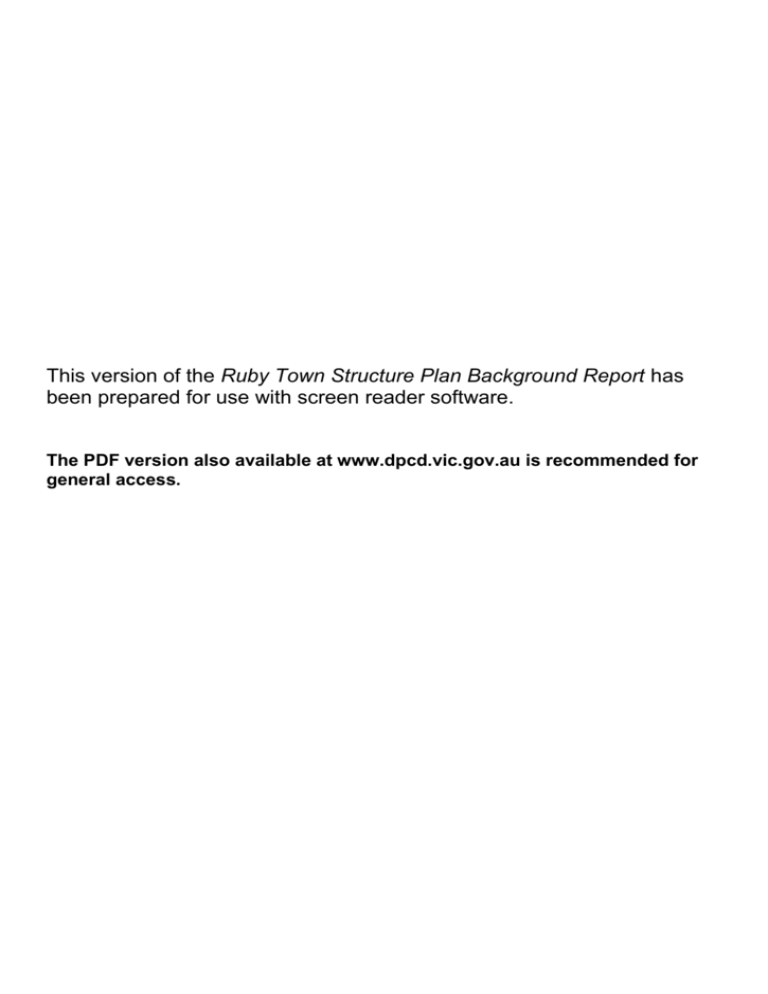
This version of the Ruby Town Structure Plan Background Report has been prepared for use with screen reader software. The PDF version also available at www.dpcd.vic.gov.au is recommended for general access. Ruby Town Structure Plan background report outline The Structure Plan will need to be supported by a comprehensive background report. An outline of a sample table of contents is provided below, which addresses; local issues, physical and social infrastructure and environmental conditions which should be included in the background report. The background report should include text and maps. The map base should be the same for each issue area. This would allow a composite summary map or sieve map to be produced for issues and recommendations. 1. Executive Summary 2. Introduction – purpose of document, links to the Structure Plan 3. Policy context – Melbourne 2030 & Municipal Strategic Statement, other relevant Council policies Text and maps to address and summarise the following: 4. Demographic, Housing and Economic Profile, Analysis and Recommendations Demographic characteristics and profile Analysis of 2006 Census; relevant Statistical Local Area (SLA) and municipal context. Analysis of recent work undertaken by Council and consultants to Council Summary of population statistics, age structure and population trends, growth rates and cultural diversity Housing trends Analysis of current demand, capacity and future requirements, household numbers, household size Analysis of housing affordability, housing prices and stock, interest rates and rental prices Identify key sites, opportunities and potential partnerships for social housing development projects Economic profile 2006 Census employment and economic analysis, income distribution, household income, employment types, occupation profile, education and qualifications Industrial land-use strategies Retail and commercial analysis Economic analysis of activity centre 5. Movement and Transport Analysis and Recommendations Analysis of 2006 Census journey to work and car ownership information Analysis of Integrated Transport Plan Public Transport Mapping train, tram, bus routes, analysis of frequency of services (weekdays and weekends), interchanges, integration of transport modes, potential for service enhancement and additional services Analysis of the integration between public transport modes and land uses Cycling Mapping and analysis of commuter and recreational cycle paths, identify opportunities for improvements to amenity, signage, maintenance, bicycle parking and links Roads Identify hierarchy and function of key transport routes Analyse key intersection design, function, safety, signalling times, road congestion and travel times Record and review traffic volumes on key transport routes Review volume, access and movement patterns of commercial vehicles and heavy vehicles in the core employment precinct Car parking Map key car park sites Identify level of use, capacity and demand for car parking in the activity centre Identify redundant, or under utilised car parks with redevelopment potential, and potential for underground carparks Pedestrians Map existing and anticipated pedestrian activity and key nodes within 400-800m of the activity centre Prepare spatial analysis and pedestrian modelling Identify links between key activity nodes Identify pedestrian priority streets Identify any pedestrian safety and amenity issues in key activity nodes 6. Physical infrastructure Analysis and Recommendations Identification of any key environmental issues, including, air quality, noise related issues, waterways and water quality, potentially contaminated land, soil type and identifying constraints and opportunities for development Analysis of existing and future capacity of water supply, sewerage and drainage services, Opportunities for sustainable infrastructure and management; such as water tanks, water re-use schemes, water sensitive urban design and stormwater management Analysis of existing and future capacity of electricity, natural gas and telecommunications infrastructure Identify opportunities for the co-ordinated provision of infrastructure Identify opportunities for the introduction of high speed broadband infrastructure in the activity centre 7. Social Infrastructure Analysis and Recommendations Analyse projected demographic changes and consider the impact on current and future social infrastructure Prepare a plan for social infrastructure; addressing network and hierarchy of social facilties and services in the context of the activity centre; addressing education, health, social, cultural, recreation, entertainment, and emergency services etc Analysis of existing capacity of service delivery and implications for future spatial and service delivery requirements 8. Built form Analysis and Recommendations Analyse existing/develop new built form guidelines and controls for the activity centre precincts, and key development sites in the activity centre, including setbacks from the street boundary, active frontages, preferred maximum heights, landmark sites, streetscape character, pedestrian links, scale, and street condition Analyse neighbourhood character studies and streetscape guidelines Identify key areas for urban renewal Identify any key heritage sites 9. Heritage Analysis and Recommendations Analyse existing Aboriginal and non Aboriginal cultural heritage studies Identification of key heritage sites in the activity centre Identification of sites which need to be included in heritage overlays Identification of opportunities for re-use and redevelopment of heritage buildings 10. Recreation facilities and needs Analysis and Recommendations Review recreation needs studies, identify opportunities for future services and facilties Prepare an analysis of the hierarchy of existing recreation facilities and services, identifying current levels of use and potential future demand. Identify any site requirements for expansion of facilities 11. Community arts and cultural Analysis and Recommendations Identify key community arts and cultural services, facilities and precincts Identify potential future demand for services and facilities and any site requirements for expansion of facilities and programs 12. Open space Analysis and Recommendations Map existing passive and active open space areas and open space networks Identify priorities and opportunities for redesign and redevelopment addressing; quality, design, access (pedestrian and cycle), facilities, safety and lighting Identify potential new open space opportunities and links, especially in neighbourhoods with poor access to open space Analyse recommendations from master plans prepared for key open space areas Analyse recommendations from community needs studies 13. Environment and sustainability Analysis and Recommendations Undertake an analysis of landscape character, landscape constraints, land capability, topography, key landscape features, slope, winds, significant views and where edge treatments are required Identify biodiversity values in the activity centre including sites of flora and fauna significance, waterways, and any significant animal movement and habitat corridors Identify opportunities to enhance biodiversity and conservation values 14. Community engagement strategy Prepare a Community and Stakeholder Engagement Plan at the commencement of the project, with input from the Project Steering Committee, to identify the following: Previous consultation that has occurred and implications for the Plan Determine what components of the Plan the community and stakeholders can influence, and what aspects of the Structure Plan are not negotiable Stakeholders who need to be engaged (including agencies, departments, developers, landowners, business community, community groups, action groups and residents) How to engage with community who are “harder to reach” including people with disabilities, young people, people whose first language is not English, busy people and business people How and when to engage agencies and key stakeholders at decision making points The level of engagement appropriate for community and different stakeholders (inform, consult, involve, collaborate or empower) at the various stages of the project, for example commencement of project, identification of key issues, development of options, finalisation of Structure Plan, implementation of Structure Plan (refer to IAP2 Spectrum of Public Participation at www.iap2.org) The time frame for community and stakeholder input and how this information will be included in the plan A range of engagement opportunities for stakeholders and the community Consultation budget Is a community engagement specialist required? Refer to the revised Structure Planning Practice Note: Structure Planning for Activity Centres and Planning your Community and Stakeholder Engagement Strategy, DPCD 2009. 15. Vision Develop a shared vision for a preferred future for the centre, and the principles and aspirations to guide change Provide the basis for the objectives, strategies and initiatives for future form and development outlined in the Structure Plan Address the priorities and long-term objectives of the Council and the Municipal Strategic Statement (MSS) 16. Summary of Recommendations Explanatory dot points, demonstrating relationship to Structure Plan Published by the Department of Planning and Community Development, 1 Spring Street, Melbourne Vic 3000 April 2010 ©Copyright State Government of Victoria 2010. This publication is copyright. No part may be reproduced by any process except in accordance with provisions of the Copyright Act 1968. Authorised by the Victorian Government, Melbourne Printed by Stream Solutions Pty Ltd Printed on 55% recycled paper ISBN 978-1-921607-43-1 DISCLAIMER This publication may be of assistance to you but the State of Victoria and its employees do not guarantee that the publication is without flaw of any kind or is wholly appropriate for your particular purposes and therefore disclaims all liability for any error, loss or other consequence which may arise from you relying on any information in this publication. ACCESSIBILITY This publication is published in PDF and Word formats on www.dpcd.vic.gov.au
